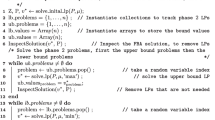Abstract
Flux Variability Analysis (FVA) is an important method to analyze the range of fluxes of a metabolic network. FVA consists in performing a large number of independent optimization problems, to obtain the maximum and minimum flux through each reaction in the network. Although several strategies to make the computation more efficient have been proposed, the computation time of an FVA can still be limiting. We present a two-step procedure to accelerate the FVA computational time that exploits the large presence within metabolic networks of sets of reactions that necessarily have an identical optimal flux value or only differ by a multiplication constant. The first step identifies such sets of reactions. The second step computes the maximum and minimum flux value for just one element of each of set, reducing the total number of optimization problems compared to the classical FVA. We show that, when applied to any metabolic network model included in the BiGG database, our FVA algorithm reduces the total number of optimization problems of about 35\(\%\), and the computation time of FVA of about 30%.
Access this chapter
Tax calculation will be finalised at checkout
Purchases are for personal use only
Similar content being viewed by others
References
Broddrick, J.T., et al.: Unique attributes of cyanobacterial metabolism revealed by improved genome-scale metabolic modeling and essential gene analysis. Proc. Natl. Acad. Sci. 113(51), E8344–E8353 (2016)
Brunk, E., et al.: Recon3d enables a three-dimensional view of gene variation in human metabolism. Nat. Biotechnol. 36(3), 272–281 (2018)
Cavill, R., Jennen, D., Kleinjans, J., Briedé, J.J.: Transcriptomic and metabolomic data integration. Briefings Bioinf. 17(5), 891–901 (2016)
Damiani, C., Gaglio, D., Sacco, E., Alberghina, L., Vanoni, M.: Systems metabolomics: from metabolomic snapshots to design principles. Curr. Opin. Biotechnol. 63, 190–199 (2020)
Di Filippo, M., et al.: Integrate: model-based multi-omics data integration to characterize multi-level metabolic regulation. PLoS Comput. Biol. 18(2), e1009337 (2022)
Ebrahim, A., Lerman, J.A., Palsson, B.O., Hyduke, D.R.: COBRapy: constraints-based reconstruction and analysis for python. BMC Syst. Biol. 7(1), 1–6 (2013)
Fallahi, S., Skaug, H.J., Alendal, G.: A comparison of monte Carlo sampling methods for metabolic network models. PLoS ONE 15(7), e0235393 (2020)
Galuzzi, B.G., Vanoni, M., Damiani, C.: Combining denoising of RNA-seq data and flux balance analysis for cluster analysis of single cells. BMC Bioinform. 23(6), 1–21 (2022)
Gudmundsson, S., Thiele, I.: Computationally efficient flux variability analysis. BMC Bioinform. 11(1), 1–3 (2010)
Hefzi, H., et al.: A consensus genome-scale reconstruction of Chinese hamster ovary cell metabolism. Cell Syst. 3(5), 434–443 (2016)
Heirendt, L., Thiele, I., Fleming, R.M.: DistributedFBA. jl: high-level, high-performance flux balance analysis in Julia. Bioinformatics 33(9), 1421–1423 (2017)
Herrmann, H.A., Dyson, B.C., Vass, L., Johnson, G.N., Schwartz, J.M.: Flux sampling is a powerful tool to study metabolism under changing environmental conditions. NPJ Syst. Biol. Appl. 5(1), 1–8 (2019)
Hyduke, D.R., Lewis, N.E., Palsson, B.Ø.: Analysis of omics data with genome-scale models of metabolism. Mol. BioSyst. 9(2), 167–174 (2013)
King, Z.A., Dräger, A., Ebrahim, A., Sonnenschein, N., Lewis, N.E., Palsson, B.O.: Escher: a web application for building, sharing, and embedding data-rich visualizations of biological pathways. PLoS Comput. Biol. 11(8), e1004321 (2015)
Levering, J., et al.: Genome-scale model reveals metabolic basis of biomass partitioning in a model diatom. PLoS ONE 11(5), e0155038 (2016)
Mahadevan, R., Schilling, C.H.: The effects of alternate optimal solutions in constraint-based genome-scale metabolic models. Metab. Eng. 5(4), 264–276 (2003)
Müller, A.C., Bockmayr, A.: Fast thermodynamically constrained flux variability analysis. Bioinformatics 29(7), 903–909 (2013)
Nielsen, J.: Systems biology of metabolism: a driver for developing personalized and precision medicine. Cell Metab. 25(3), 572–579 (2017)
Norsigian, C.J., et al.: BiGG models 2020: multi-strain genome-scale models and expansion across the phylogenetic tree. Nucleic Acids Res. 48(D1), D402–D406 (2020)
Orth, J.D., Fleming, R.M., Palsson, B.Ø.: Reconstruction and use of microbial metabolic networks: the core Escherichia coli metabolic model as an educational guide. EcoSal Plus 4(1) (2010)
Orth, J.D., Thiele, I., Palsson, B.Ø.: What is flux balance analysis? Nat. Biotechnol. 28(3), 245–248 (2010)
Schellenberger, J., et al.: Quantitative prediction of cellular metabolism with constraint-based models: the cobra toolbox v2. 0. Nat. Protoc. 6(9), 1290–1307 (2011)
Thiele, I., Gudmundsson, S.: Computationally efficient flux variability analysis. BMC Bioninform. 11(489), 1–3 (2010)
Thiele, I., Fleming, R.M., Bordbar, A., Schellenberger, J., Palsson, B.Ø.: Functional characterization of alternate optimal solutions of Escherichia coli’s transcriptional and translational machinery. Biophys. J . 98(10), 2072–2081 (2010)
Thomas, A., Rahmanian, S., Bordbar, A., Palsson, B.Ø., Jamshidi, N.: Network reconstruction of platelet metabolism identifies metabolic signature for aspirin resistance. Sci. Rep. 4(1), 1–10 (2014)
Virtanen, P., et al.: SciPy 1.0: fundamental algorithms for scientific computing in Python. Nat. Methods 17(3), 261–272 (2020)
Author information
Authors and Affiliations
Corresponding author
Editor information
Editors and Affiliations
Rights and permissions
Copyright information
© 2023 The Author(s), under exclusive license to Springer Nature Switzerland AG
About this paper
Cite this paper
Galuzzi, B.G., Damiani, C. (2023). An Efficient Implementation of Flux Variability Analysis for Metabolic Networks. In: De Stefano, C., Fontanella, F., Vanneschi, L. (eds) Artificial Life and Evolutionary Computation. WIVACE 2022. Communications in Computer and Information Science, vol 1780. Springer, Cham. https://doi.org/10.1007/978-3-031-31183-3_5
Download citation
DOI: https://doi.org/10.1007/978-3-031-31183-3_5
Published:
Publisher Name: Springer, Cham
Print ISBN: 978-3-031-31182-6
Online ISBN: 978-3-031-31183-3
eBook Packages: Computer ScienceComputer Science (R0)




